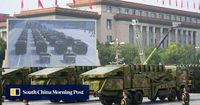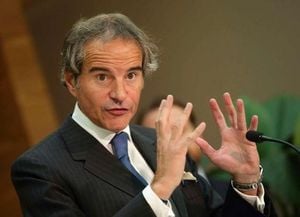On September 3, 2025, the heart of Beijing pulsed with spectacle and symbolism as China staged a massive military parade to mark the 80th anniversary of its victory in World War II and the end of the Chinese People’s War of Resistance Against Japanese Aggression. The parade, held in the iconic Tiananmen Square, was more than a commemoration—it was a calculated display of military might, diplomatic outreach, and nationalistic messaging, according to detailed reporting from China News Service and The New York Times.
The 90-minute event, presided over by President Xi Jinping, showcased a formidable array of advanced weaponry: unmanned intelligence and counter-unmanned equipment, hypersonic missiles, directed-energy weapons, electronic jamming systems, and strategic arms capable of global strikes. The grand finale saw 80,000 doves and balloons released into the sky, a gesture of peace that stood in stark contrast to the martial hardware on display. Over 50,000 spectators watched as more than 25 heads of state—including Russia’s Vladimir Putin and North Korea’s Kim Jong Un—joined Xi at the reviewing stand, marking a rare public convergence of these leaders.
This was only the second such parade since 2015, and it came at a time when China faces both economic headwinds and heightened tensions with the United States. Xi Jinping’s words from the rostrum rang with both pride and defiance: "The rejuvenation of the Chinese nation is unstoppable." He drew a direct line between the sacrifices made during World War II and the contemporary challenges facing China, declaring, "When faced in the past with a life-and-death struggle between justice and evil, light and darkness, progress and reaction, the Chinese people united in hatred of the enemy and rose up in resistance." According to The New York Times, Xi’s remarks were a clear signal that China would continue to stand firm on the world stage, ready to choose "dialogue over confrontation" and "progress over conflict."
The symbolism extended beyond the military. Representatives and family members from countries that supported China during WWII—including Russia, the United States, the United Kingdom, France, and Canada—were invited, highlighting a message of international solidarity. Yet, as Le Monde editorialized, the event also placed Xi "at the center of the world stage and promoted his vision of rebalancing the international order in the face of the US, an increasingly unpredictable superpower."
Observers noted that the parade was as much about projecting strength to the Chinese public as it was about commemorating history. Analysts cited by The Wall Street Journal and South China Morning Post agreed: the Communist Party sought to stoke nationalism, recast China’s role in World War II, and present itself as the nation’s savior against foreign aggressors. The evocation of wartime memories, in their view, was designed to rally domestic support in the face of economic uncertainty and international rivalry—especially with the United States, which Xi has repeatedly accused of trying to contain China’s rise.
On Chinese social media, the parade was a sensation. According to Manya Koetse of What’s On Weibo, there were about 225 trending hashtags related to the event and its preparations across platforms like Weibo, Douyin, and Kuaishou, with military themes dominating the conversation. Some users marveled at the technological prowess on display; others, like one Zhihu respondent, hoped for more investment in public welfare: "I hope they’ll spend less money and use it towards improving people’s livelihoods." Taiwanese officials estimated that the parade cost $5 billion—about two percent of China’s annual defense budget.
Perhaps the most striking image was the "symbolic walk of solidarity" by Xi, Putin, and Kim Jong Un—a first for the trio and a vivid demonstration of China’s willingness to stand by its allies, even those considered pariahs by much of the international community. As Wen-ti Sung of the Atlantic Council’s Global China Hub put it, "China is unafraid to stand by its friends and be their literal fellow traveller, even and perhaps especially when they are pariahs in the court of international public opinion." Social media users reacted with a mix of awe and humor, with one quipping, "All three countries have leaders for life, cut from the same cloth."
The parade was the capstone of a weekslong campaign by the Communist Party to reinforce its narrative of historical righteousness and present itself as a force for global stability. A recent censorship directive, as reported by China Digital Times, instructed regulators to guard against "erroneous historical views" and "American and Western anti-China forces intensifying their competition with us for discourse power over the history of the war." The message was clear: China’s role in WWII is not just a matter of history, but a pillar of its current legitimacy and global ambitions.
The momentum from the parade carried directly into the Shanghai Cooperation Organization (SCO) Summit, held in Tianjin from August 31 to September 1, 2025. The summit brought together leaders from over 20 countries and 10 international organizations, further cementing China’s diplomatic clout. President Xi used the occasion to unveil the Global Governance Initiative (GGI), which he described as a push for a "more just and equitable global governance system." The GGI, according to an official concept paper, is built on five pillars: sovereign equality, international rule of law, multilateralism, a "people-centered" approach, and real results.
The summit also saw the approval of a development strategy for the SCO covering 2026-2035, and the announcement of a new development bank, $280 million in aid, and $1.4 billion in loans to member states. Coordination platforms for cooperation on energy, sustainable industry, and digital trade were also introduced. As Eric Olander of the China-Global South Project observed, "the likes of Xi and Putin feel that momentum is on their side in their confrontation with a West that is now so divided, it’s hard to even say what the 'West' is anymore."
China’s commemorative activities extended beyond the parade and the summit. On August 31, 2025, the government released its fourth list of war memorials, honoring both domestic and international contributions to the war effort, including 34 new national-level facilities and 43 renowned heroes and groups. These measures, along with the parade and summit, were all part of a coordinated effort to reinforce China’s narrative of historical legitimacy and future leadership.
For many observers, these events signaled a China increasingly confident in its power and determined to shape the global order on its own terms. As Rana Mitter of Harvard’s Kennedy School told The Wall Street Journal, "China’s Communist Party, by stressing its role in World War II, is seeking 'co-ownership of the postwar international order.'" The message from Beijing was unmistakable: China is not merely a participant in the global system—it aims to be a rule-maker.
In a week marked by pageantry, diplomacy, and carefully crafted messaging, China sought to remind the world—and its own citizens—of its past sacrifices, present strength, and future ambitions. The spectacle in Tiananmen Square was both a look back at history and a bold statement about the nation’s trajectory in a turbulent world.






